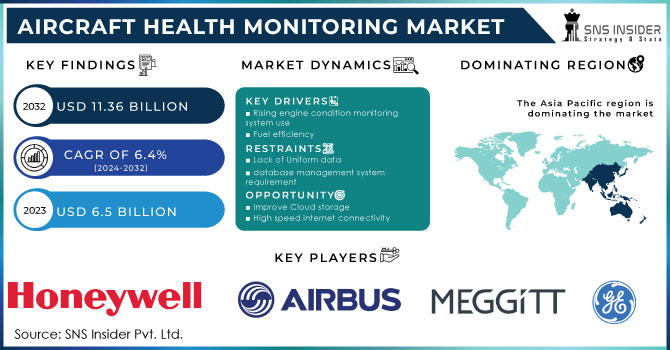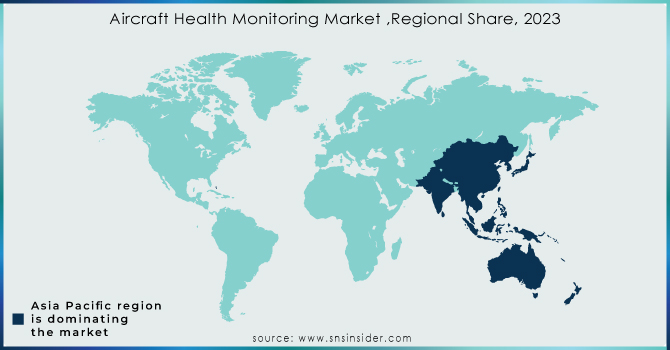Aircraft Health Monitoring Market Report Scope & Overview:

To get more information on Aircraft Health Monitoring Market - Request Free Sample Report
The Aircraft Health Monitoring Market Size was valued at USD 6.5 billion in 2023 and is expected to reach USD 11.36 billion by 2032 with a growing CAGR of 6.4% over the forecast period 2024-2032.
Because of its critical role in increasing overall aviation safety, the worldwide aircraft health monitoring market has grown steadily over the years. The aircraft health monitoring system integrates a wide range of software and hardware tools, procedures, approaches, and solutions for monitoring aeroplane data in order to understand aircraft performance and serviceability. This technology makes use of large amounts of aviation data to provide improved analytical output while also ensuring the safety of various planes. AHMS implementation aids in the reduction of operating and maintenance costs.
The market is being driven by an increased desire to improve aircraft safety, performance, and operational efficiency, as well as an increase in demand for real-time aircraft data monitoring systems. Another key factor supporting the growth of the aviation health monitoring systems market is the increased adoption of connected aircraft solutions.
The need to cut MRO costs is another reason influencing the adoption of advanced aircraft health monitoring systems. Continuous monitoring of aircraft systems prevents the need for quick parts and component replacements. The aviation health monitoring system market is expanding due to increased need for real-time problem management, custom alerting and analysis solutions, and performance monitoring. Furthermore, growing aerospace IT investment in developing countries, as well as technical developments for workflow optimization, drive demand for advanced analytical systems, propelling market growth.
MARKET DYNAMICS
KEY DRIVERS
-
Rising engine condition monitoring system use
-
Fuel efficiency
RESTRAINTS
-
Lack of Uniform data
-
database management system requirement
OPPORTUNITIES
-
Improve Cloud storage
-
High speed internet connectivity
CHALLENGES
-
High cost
IMPACT OF COVID-19
The COVID-19 influence on the aircraft health monitoring system industry is unknown, although it is expected to last for a few years. The COVID-19 outbreak compelled governments around the world to impose strict lockdowns and ban import–export activities for the majority of 2020 and a few months in 2021. This resulted in a sharp drop in demand for air travel, and thousands of flights were grounded around the world. Furthermore, nationwide lockdowns led aircraft health monitoring system manufacturing sites to shut down partially or fully. The COVID-19 pandemic has caused global delays in actions and initiatives aimed at developing enhanced aviation health monitoring systems.
The aircraft health monitoring market has been classified based on end user. MRO, OEMs, and airlines are all considered in the aircraft health monitoring industry. According to estimates, the aircraft health monitoring market is dominated by MRO. One of the most important factors driving the MRO segment in the aircraft health monitoring market is the increase in aircraft modernization programmers.
The aircraft health monitoring market has been divided into three segments based on the platform: commercial aviation, business and general aviation, and military aviation. Because of the strong need for health monitoring systems, solutions, and services, commercial aviation will have the highest growth in the aircraft health monitoring market. Commercial airlines are focusing on deploying these solutions to lower the operational expenses of their air fleets, which will drive market growth throughout the forecast timeframe. The aviation health monitoring market is divided into three segments based on solution: hardware, software, and services. The hardware sector is expected to lead the aviation health monitoring market in 2022, with the highest market share. The increased use of sensors in engines to assess real-time condition data for preemptive failure detection will drive aviation health monitoring demand over the forecast period.
KEY MARKET SEGMENTATION
By Solution
-
Hardware
-
Software
-
Services
By End User
-
Oems
-
Mro
-
Airlines
By Aircraft Type
-
Fixed Wing Aircraft
-
Helicopter
By Platform
-
Commercial
-
Business & General
-
Military Aviation
By Installation
-
On board
-
On Ground
By Fit
-
Line-fit
-
Retrofit
REGIONAL ANALYSIS
During the forecast period, Asia Pacific is expected to be the fastest-growing region in the aircraft health monitoring market, owing to significant increase in air transport. The region contains a diverse mix of countries and aviation needs; by 2038, it is expected to have the largest number of aircraft deliveries of any region. The increased delivery of aircraft will eventually contribute to the expansion of the aviation health monitoring business. The growing demand for aircraft models such as the A380, A350 XWB, B787 Dreamliner, B777, and other AHMS integrated aircraft types will sustain regional market demand. Airbus Real-Time Health Monitoring and Airplane Health Management are the health monitoring systems provided by Airbus and Boeing, respectively.

Need any customization research on Aircraft Health Monitoring Market - Enquiry Now
REGIONAL COVERAGE:
-
North America
-
USA
-
Canada
-
Mexico
-
-
Europe
-
Germany
-
UK
-
France
-
Italy
-
Spain
-
The Netherlands
-
Rest of Europe
-
-
Asia-Pacific
-
Japan
-
south Korea
-
China
-
India
-
Australia
-
Rest of Asia-Pacific
-
-
The Middle East & Africa
-
Israel
-
UAE
-
South Africa
-
Rest of Middle East & Africa
-
-
Latin America
-
Brazil
-
Argentina
-
Rest of Latin America
-
KEY PLAYERS
The Major Players are Honeywell International Inc, Airbus, FLYHT Aerospace Solutions Ltd., General Electric, Meggitt PLC, RSL Electronics Ltd, Raytheon Technologies Corporation, The Boeing Company, Rolls-Royce PLC, Teledyne Controls LLC, and Other Players
| Report Attributes | Details |
|---|---|
| Market Size in 2023 | US$ 6.5 Billion |
| Market Size by 2032 | US$ 11.36 Billion |
| CAGR | CAGR of 6.4% From 2024 to 2032 |
| Base Year | 2023 |
| Forecast Period | 2024-2032 |
| Historical Data | 2020-2022 |
| Report Scope & Coverage | Market Size, Segments Analysis, Competitive Landscape, Regional Analysis, DROC & SWOT Analysis, Forecast Outlook |
| Key Segments | • By End User (Oems, Mro, Airlines) • By Solution (Hardware, Software, Services) • By Installation (Onboard, On Ground) • By Fit (Line-fit, Retrofit) • By Aircraft Type (Fixed Wing Aircraft, Helicopter) • By Platform (Commercial, Business & General, Military Aviation) |
| Regional Analysis/Coverage | North America (USA, Canada, Mexico), Europe (Germany, UK, France, Italy, Spain, Netherlands, Rest of Europe), Asia-Pacific (Japan, South Korea, China, India, Australia, Rest of Asia-Pacific), The Middle East & Africa (Israel, UAE, South Africa, Rest of Middle East & Africa), Latin America (Brazil, Argentina, Rest of Latin America) |
| Company Profiles | Honeywell International Inc, Airbus, FLYHT Aerospace Solutions Ltd., General Electric, Meggitt PLC, RSL Electronics Ltd, Raytheon Technologies Corporation, and The Boeing Company, Rolls-Royce PLC, Teledyne Controls LLC, and other players. |
| DRIVERS | • Rising engine condition monitoring system use • Fuel efficiency |
| RESTRAINTS | • Lack of Uniform data • database management system requirement |

